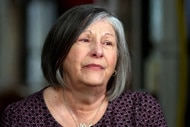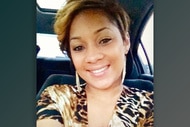Create a free profile to get unlimited access to exclusive videos, breaking news, sweepstakes, and more!
Who Was The Axe Murderer Who Brutalized An 1800s Home? The Lizzie Borden Case, Explained
Lizzie Borden was ultimately acquitted in the killings of Andrew and Abby Borden, but the allegations have made her an infamous figure in American history.

The 1892 murders of Andrew and Abby Borden shocked the nation, making headlines due to the brutality of the killings and the fact the prime suspect was a young woman: Andrew's 32-year-old daughter, Lizzie Borden.
While Lizzie was arrested and brought to trial, she was ultimately acquitted in the murders — but that hasn't stopped the general public from considering her the probable killer, even turning the crime into a childhood playground rhyme you've likely heard before: "Lizzie Borden took an axe, And gave her mother forty whacks. When she saw what she had done, She gave her father forty-one."
Another fascinating aspect of the case is what was going on when it happened: Andrew and Abby were both killed while Lizzie and the maid, Bridget, were in or around the home. How could they have not heard someone enter and viciously slaughter two people with an axe?
Well, as bizarre as it sounds, sometimes people really are home when a crime occurs — and they see or hear nothing. Those kind of crimes, where someone wakes up to find someone killed in their residence, are featured in the new Oxygen series "Sleeping With Death," premiering Sunday, November 6 at 7/6c on Oxygen.
So, what happened in the Lizzie Borden case? What did it mean that she and the family maid, Bridget "Maggie" Sullivan, were both at the residence when horrific murders happened?
The killings occurred on August 4, 1892 in the Bordens' Fall River, Massachusetts home. The night before, Lizzie's uncle John Morse had arrived to spend the night. He had breakfast the following morning with Andrew, Abby, Lizzie, and Bridget. Morse headed into the town at around 9 a.m. to run errands, planning to return later, while Andrew left for a walk and Abby went to clean upstairs, according to CBS' "48 Hours."
Andrew returned at around 10:30 a.m.; when he was unable to make his key work, Bridget had to let him in. This moment would prove crucial in the case, as Bridget claimed she heard Lizzie upstairs laughing when this occurred, reported The New York Times. If she was upstairs on the second floor, she would have already been aware that Abby had been brutally slaughtered with a hatchet on that floor while Andrew was out.
Andrew settled down for a nap on the sofa, while Bridget went to rest as well in her room. But at around 11:10 a.m., she later said, Lizzie called for her, telling her Andrew was killed. He had been attacked while on the couch and struck multiple times with a hatchet. His time of death was later determined to be around 11 a.m., according to "48 Hours."
When help arrived, Abby was found dead in the guest room. She, too, had been struck repeatedly in the head with a hatchet.
RELATED: Did 'The Vampire Rapist' Inspire The Holiday Horror Hit Film 'Black Christmas'?
Suspicion quickly fell on Lizzie, as there was no sign of forced entry into the house — "The house was triple locked in the front door, and the back door was locked. And the only door that could have been unlocked was the side door," explained crime scene investigator Erin Rubas in CBS' "48 Hours."
A potential murder weapon, a hatchet with the handle broken off, was also found hiding in the Bordens' basement. And while Lizzie didn't have visible bloodstains on her clothing, it soon came out that she had burned a dress in her stove in the days after the murder. She and her sister, Emma, who was out of town when the killings occurred, maintained she burned the dress because it was covered in paint stains, according to "48 Hours." Still, it struck detectives as suspicious.
While Lizzie certainly had opportunity, investigators determined she likely had motive, too. Although she mostly got along with her father, it was said he could be controlling and he was often described as cheap and miserly, according to The Chicago Tribune. Even though he was a well-off businessman, the family home where his two adult daughters lived was not run like an abode belonging to a wealthy man due to his penny pinching, which they theorized may have caused familial resentment — especially because when Abby's half-sister needed a home, he bought one for her and put it in Abby's name, according to "48 Hours."
Lizzie and Emma also had a tense relationship with Abby, reported The Chicago Tribune.
Another piece of evidence against Lizzie was that she allegedly attempted to purchase prussic acid, a deadly poison, from a pharmacist only a day before the murders occurred, according to The New York Times.
"The woman … said that she needed it to put an edge on a seal-skin cape. And we know that Lizzie Borden did, in fact, have seal-skin capes. But the pharmacist said he never heard of it used that way and refused to sell it to her," Cara Robertson, an author, told "48 Hours."
Lizzie was charged with murder in December 1892, and her trial, which was a media sensation, began in June 1893. The prosecution only had circumstantial evidence against Lizzie, however, and she was ultimately acquitted of the murders. She lived out the rest of her days in Fall River before dying in 1927 of pneumonia, according to The Smithsonian.
No one was ever convicted in connection with the crime.
So, who really killed Andrew and Abby? Many people consider Lizzie to have been the true killer who evaded justice due to both her gender and the lack of hard proof, although others have pointed the finger at Bridget, John Morse, and Emma, among others. The truth of what happened in the house that day may never be known.
For more on crimes that occurred when someone was in the home, watch Oxygen series "Sleeping With Death," premiering Sunday, November 6 at 7/6c on Oxygen.




























